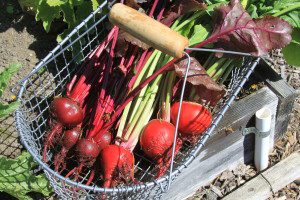Mar. 20 column: Anthocyanins

Happy Spring, everyone!
Are you familiar with anthocyanins or am I making you scratch your head? They are pigments that give purple, red and blue hues to different species or varieties of plants — whether it’s in their leaves or flowers.
And they’re very healthful, although scientists haven’t completely figured that part out just yet!
It just so happens that my column in today’s edition of The Spokesman-Review is about anthocyanins — what they are and what they do for us — and then I list interesting vegetable varieties with high concentrations of them.
This year, I’ve selected some different veggie cultivars to grow in my garden — won’t it be colorful?!
Here’s a link to my column: Red, blue, purple crops add color to the garden, health to the body. I hope you’ll find it interesting and that it will encourage you to plant varieties that are rich in anthocyanins.
Anthocyanins garden column:
by Susan Mulvihill
Have you gotten your dose of anthocyanins today?
What are anthocyanins?
Anthocyanins are naturally-occurring pigments that give flowers and plant foliage their purple, red or blue hues. They are part of the flavonoids, which are a class of plant compounds that provide us with micronutrients.
Studies have suggested that anthocyanins have the potential to lower blood pressure, act as anti-inflammatory and anti-bacterial agents, improve vision, and suppress the development of cancer cells in humans, among other things.
Anthocyanins can be found in vegetables and fruits such as eggplants, red cabbage, beets, red onions, blueberries, grapes, cherries and plums.
Since I already grow the fruits listed above, I’m good to go there. One change I’m making in my vegetable garden this year is to grow a lot of dark-hued crops. In addition to providing us with even healthier foods, an added benefit will be a very colorful garden.
Suggestions of vegetables that are high in anthocyanins:
If you are interested in growing red or purple veggies, here are some ideas:
Artichokes _ I typically grow green artichokes but recently located a purple heirloom variety called Violetta Precoce that I’ll be growing this season. According to the seed catalog, purple varieties are more tender than green ones. I enjoy growing them in my flower beds so Violetta Precoce should add a lot of color in addition to providing food for dinner.
Beets _ Last year, I was excited because I grew white beets which had a delicious flavor; unfortunately, that lack of pigment means no anthocyanins. Some of the darkest varieties you can find include Merlin, Red Ace, Cylindra, Bull’s Blood and Falcon.
Cabbage _ Red Acre, Omero and Integro have incredibly deep purple heads; Red Acre is notable because it stores well over the winter.
Carrots _ Dark cultivars that should provide plenty of anthocyanins are Dragon, Purple Haze, Purple 68 and Deep Purple.
Corn _ While I’ve never grown a blue corn before, Hopi Blue is very attractive. If you harvest it while it’s young, it can be eaten as a sweet corn. It can also be dried for use as a flour.
Onions _ Three long-day onion varieties that perform well in northern climates like ours are Red Hawk, Rossa di Milano and Red Wing.
Salad greens _ Red Sails has long been one of my go-to varieties for leaf lettuce but I’m interested in going even darker. Red Romaine, Thurinus and Cantarix oakleaf lettuce are deep burgundy in color. Two mustards worth considering are Red Giant and Osaka Purple. I’m growing a red Mizuna this year, which should be a delightful addition to salads.
Tomatoes _ The [trademarked name] Indigo series of tomatoes provides one-stop shopping for deeply-pigmented cultivars. Indigo Rose is 2 inches in diameter and grows vigorously, needing about 80 days to reach maturity. Indigo Blue is a cherry tomato. The largest tomato in this series is Indigo Blue Beauty, a beefsteak-style that can weigh up to 8 ounces and also requires 80 days to mature.
A word about cooking purple or blue vegetables
You might be wondering what happens to anthocyanins when you cook purple or blue veggies. According to the research studies I’ve read, boiling, steaming or microwaving them degrades these anti-oxidants. Surprisingly enough, one study determines that steaming diminishes them the most, followed closely by boiling. You will get the most nutritional benefit from eating pigmented vegetables raw. Cooking them for a minimal amount of time is the next best thing.
We all know that eating fruits and veggies is good for us. Now we have even more incentive to indulge in them.

